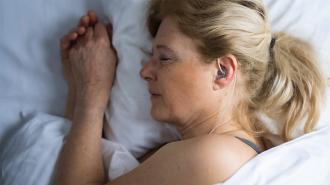An EEG device that’s worn in the ear during sleep could help doctors diagnose Parkinson’s and Alzheimer’s long before symptoms appear, when treatments are more likely to be effective.
The challenge: Parkinson’s and Alzheimer’s are two distinct neurological disorders, but they both tend to progress over long periods of time, and both are difficult to diagnose in their earliest stages.
“They’re usually only discovered when you start to develop cognitive and memory-related problems, sleep disturbances, or disturbances in the musculoskeletal system, for example,” said Preben Kidmose, head of Aarhus University’s Center for Ear-EEG. “Diagnosis is generally so late that the only treatment option is to treat the symptoms.”
A promising lead: Past research has found that people with Parkinson’s and Alzheimer’s frequently experience changes in their sleep, including abnormal brain activity, before they start developing noticeable symptoms in their waking hours.
“Diagnosis is generally so late that the only treatment option is to treat the symptoms.”
Preben Kidmose
Identifying those changes can be difficult, though. Patients often need to spend several nights in a clinic while connected to devices that monitor their brain activity, oxygen levels, and more. Even then, a few nights might not be enough for a doctor to identify subtle changes.
A device that people could use at home would allow more time for patterns to emerge, but existing at-home sleep monitors can be uncomfortable, inaccurate, or limited in what they can measure.
What’s new? Kidmose’s team at Aarhus University has developed an electroencephalogram (EEG) device that’s worn like a pair of earbuds, but instead of playing music, it measures tiny voltage changes on the surface of the skin that are produced by brain activity.
“We hope it will be possible to measure your own sleep over a few days, weeks, or even months every year.”
Poul Jørgen Jennum
Teaming up with two other organizations in Denmark — Rigshospitalet and T&W Engineering, a health tech company — they wanted to see if the device can be used to monitor sleep for early signs of Parkinson’s and Alzheimer’s.
“We hope that we’ll be able to use the ear-EEG to replace in part the existing and somewhat more troublesome sleep monitoring,” said Poul Jørgen Jennum, head of the Danish Center for Sleep Medicine at Rigshospitalet.
“We’ll try to make the technology so simple that it can be used at home and over a longer period of time,” he continued. “Ideally, we hope it will be possible to measure your own sleep over a few days, weeks, or even months every year.”
PANDA plan: During the four-year PANDA (“Progression Assessment in Neurodegenerative Disorders of Ageing”) project, Rigshospitalet will collect data through clinical tests, while Aarhus University researchers develop algorithms to identify biomarkers of disease in the data.
T&W Engineering will be responsible for incorporating sensors to measure temperature and oxygen levels into the EEG device and developing a complementary diagnostic support system for doctors.
Looking ahead: It’s too soon to say whether the PANDA project will succeed, but if the in-ear EEG device can help doctors diagnose Parkinson’s and Alzheimher’s very early, the researchers believe the impact could be extraordinary.
“In the project, we’re going to try to identify signs of the two diseases 10-15 years before the first problems begin to occur, and if we can, far better treatment options will be possible,” said Kidmose.
We’d love to hear from you! If you have a comment about this article or if you have a tip for a future Freethink story, please email us at tips@freethink.com.
